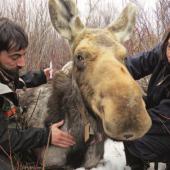Snow Cat
Bozeman's backyard beast, the lynx.
Very few of us have ever seen a lynx in the wild. To do so you must be doubly lucky, because the lynx is both shy and rare. Like the mountain lion and bobcat, the lynx is silent and reclusive, but tends to live in higher-elevation forests farther from people.
In contrast to these other wild cats, lynx numbers in the Lower 48 have sharply declined. Until the early 1970s, hundreds of lynx were trapped each year from Montana, Washington, and other northern states. Today, lynx numbers are estimated at perhaps 500 in Montana, 200 in Washington, and fewer than 100 in Colorado, the Midwest, and New England. This decline has earned the lynx protection as a threatened species under the Endangered Species Act.
Meet the Lynx
The lynx is similar to its cousin, the bobcat, but with longer legs and huge paws. Its paws are about 3 1/2 inches across—nearly that of a mountain lion, which is three to six times the lynx’s size. The lynx's paws are webbed and covered with fur, which enables it to live and hunt in the coldest, snowiest parts of North America.
The lynx’s favorite prey is the snowshoe hare, which provides 60-90% of its diet. With an acute sense of hearing and eyes that can detect tiny differences in light intensity, the lynx can successfully hunt white hares on white snow, even in low light conditions.
If you’re in a snow-covered forest where lynx still occur, look for their tracks: large and rounded like a mountain lion, but closer together and with indistinct pads due to its furry feet. Lynx are occasionally spotted in the Absaroka, Gallatin, and Madison Ranges outside of Bozeman, and they may still survive in the Bridger and Crazy Mountains. The best places in Montana to find a lynx are the Swan Valley and in and around Glacier National Park in northwest Montana.
What the Lynx Needs
The lynx is impressive for its ability to survive in some of the most rugged areas of the continent. Unlike bears and many other mammals, it remains active all winter. Despite its natural grace and tenacity, the lynx needs some help from us to survive and recover in southwest Montana and other areas of its former range.
The lynx needs a mosaic of old forest for denning and raising its young, young forest for hunting, and adequate forested cover for protection from people and other predators as it travels through its territory. In the past, periodic outbreaks of insects, disease, and forest fires produced a healthy mixture of forest stages that were beneficial to the lynx. Today, the forest tends to be more uniform due to timber cutting and fire suppression, and many areas lack the diversity the lynx needs. Also, the lynx needs large areas free from excessive human activity and developments.
Winter recreation is compatible with lynx so long as it doesn’t cause excessive noise, snow compaction, and regular disturbance by people. Snow compaction from snowmobiles and ski grooming reduces the areas where lynx can find prey and security and may allow competitors like coyotes and bobcats into lynx territory. Also, lynx do not easily negotiate large clearings and highways, so these developments may not only pose a mortality risk (from cars or other predators), they may also fragment habitat into smaller and smaller pieces that may be inadequate to support lynx.
By tailoring our use of the forests to avoid specific places and times important to lynx, we can coexist. If we succeed, people who live, work, and recreate in the forests for generations to come will have the chance to catch a glimpse of this beautiful and mysterious animal, or at least discover its tracks in the deep, soft snow.
Until his tragic death in an avalanche on December 31, 2011, David Gaillard worked to conserve lynx and other wild animals for various conservation groups in Bozeman.













